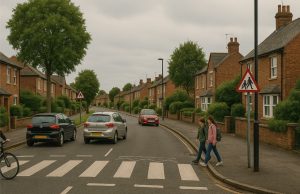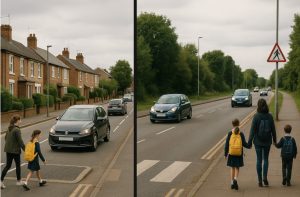Is Wrexham reversing its 20mph speed limits, and why does it matter? In a major policy shift, Wrexham has become the first council in North Wales to begin reversing elements of the controversial 20mph speed limit introduced in 2023.
As of May 2025, two roads in the town B5605 Wrexham Road/High Street in Johnstown and the A525 Bryn-Y-Grog Road, have officially returned to 30mph limits after public consultation and updated national guidance.
These are just the first two of 52 routes set for reclassification, indicating a wider move toward refining the default 20mph rollout in Wales.
This marks the first increase in speed limits in the UK in two years, breaking from the national trend toward stricter limits.
But far from being a simple reversal, Wrexham’s decision reflects a deeper, more nuanced attempt to balance road safety with practicality and public sentiment.
What Led to the Introduction of 20mph Speed Limits in the First Place?

The 20mph limit was rolled out in September 2023 by the Welsh Government as a nationwide initiative aimed at improving road safety and reducing fatalities in built-up and residential areas.
It replaced the default 30mph limit on most roads where street lights are spaced at intervals of less than 200 yards.
This policy was driven by substantial data and global examples. Cities like Edinburgh and London had previously introduced targeted 20mph zones and reported measurable reductions in road injuries and pedestrian fatalities.
Wales became the first UK nation to apply this approach as a default, intending to reduce:
- Serious and fatal road traffic collisions
- Vehicle emissions in urban zones
- Road noise in residential areas
It was also part of a broader vision embedded in the Well-being of Future Generations (Wales) Act 2015, aimed at fostering safer and more liveable communities.
Why Are Speed Limits Being Reversed in Wrexham?
While the original policy had noble intentions, the blanket nature of the rollout drew criticism from various sectors.
Concerns included its effect on commuting, the strain on emergency response times, and inconsistency in road use and design.
Many local residents questioned the cost of implementation, especially amid financial pressure on schools and health services.
Responding to these challenges, the Welsh Government revised its guidance in late 2024, allowing councils greater autonomy in identifying exceptions to the 20mph rule.
Roads that do not serve primarily residential or pedestrian-heavy areas can now be considered for reclassification to 30mph or higher.
In Wrexham’s case, the decision to reverse speed limits began with extensive public consultation. Local authorities reviewed individual roads, prioritising those used as through routes or situated outside densely populated areas.
This resulted in the decision to increase the speed limits on the B5605 and A525, setting a precedent for other councils.
Which Roads Have Already Seen Their Speed Limits Reversed?
Wrexham County Borough Council has taken proactive steps to implement the guidance changes, starting with the following roads:
| Road Name | Previous Limit | Current Limit | Reason for Change |
| B5605 Wrexham Rd/High Street | 20mph | 30mph | Arterial road with low pedestrian activity |
| A525 Bryn-Y-Grog Road | 20mph | 30mph | High traffic flow, minimal residential zones |
These are the first of 52 road sections under review. According to officials, most changes will be completed before the summer holidays, aligning with both public demand and funding deadlines.
What Has Been the Public Response in Wrexham?

Public reaction has been highly divided. While some residents see the original 20mph rollout as a well-intentioned measure gone too far, others support the goal of safer streets.
Locals like Samantha Challis voiced frustration:
“Disgusting waste of precious resources while our schools and health services go poor… but at least common sense has prevailed and we can all get back to normal.”
Another resident, Juliet Ann Williams, said:
“They should have never been changed in the first place it was just a waste of money, especially when our schools and hospitals are having to make cuts.”
Others, however, argue that reverting to 30mph risks undermining the broader goal of safer, slower, and more community-friendly roads.
This reflects the broader tension: many support lower limits near schools and estates but disagree with applying them across entire towns or cities.
What Is the Government’s Current Policy on 20mph Zones?
Transport Secretary Ken Skates clarified the government’s position during a visit to Wrexham Road, where changes were underway.
He stressed that the objective of 20mph zones was always to save lives, reduce crashes, and make public spaces safer. However, he acknowledged the importance of applying the policy correctly:
“This is about getting the right speeds on the right roads, building from the broad consensus that 20mph is right where people live, work and play.”
The revised guidance empowers councils to make localised decisions based on traffic volume, pedestrian activity, and community feedback.
While there is no fixed deadline to implement changes, funding support is available only for the 2024–25 financial year, creating an incentive for timely decision-making.
Are Other Welsh Councils Following Wrexham’s Lead?
Yes. Several councils are now revisiting their 20mph zones based on the revised guidelines:
- Flintshire: Identified multiple roads for review and has begun adjustments
- Anglesey: Launched a consultation involving 25 routes, expected to revert to 30mph
- Gwynedd and Conwy: Monitoring the impact before finalising changes
The implementation pace varies, with Wrexham being the first to act decisively, serving as a model for the rest of Wales.
Is There Evidence That 20mph Zones Improve Safety?

Numerous studies across the UK and Europe have shown that 20mph speed limits in urban areas can significantly reduce the number and severity of road traffic collisions.
According to the UK’s Department for Transport:
- Collisions are reduced by up to 40% in well-enforced 20mph zones.
- The survival rate for pedestrians hit at 20mph is significantly higher than those struck at 30mph.
- Emissions also reduce due to smoother driving patterns, especially in urban environments.
That said, effectiveness depends on appropriate application. Blanket implementation can backfire by diluting public support and overstretching enforcement resources.
Targeting the right roads, as the updated policy allows, aims to balance safety with functionality.
What Does the Future Hold for Speed Limit Policy in Wales?
The Welsh Government remains committed to reducing road deaths, but the process is now being tailored and decentralised.
Councils are being given the responsibility to identify roads suitable for each speed bracket while involving local residents in the process.
Looking forward:
- Road changes in Wrexham will continue through summer 2025
- Councils must act before financial year-end to utilise allocated funds
- The public will likely see more hybrid networks with mixed speed limits based on purpose and location
FAQs about Speed Limit Changes in Wrexham
Are all roads in Wrexham returning to 30mph?
No, only roads that do not meet the updated criteria for 20mph will revert. Many residential and school zones will retain the lower limit.
What is the revised Welsh Government guidance on speed limits?
It allows councils to decide locally where 20mph or 30mph is appropriate, based on traffic and safety data.
How many roads in Wrexham will change?
Wrexham County Borough Council plans to revise speed limits on at least 52 road sections.
Will these changes affect pedestrian safety?
When applied appropriately, both 20mph and 30mph limits can ensure safety. The key is matching speed to road use.
Is this policy change permanent?
No decision is necessarily permanent. Roads may be reassessed based on accident data and community feedback.
What happens if a driver exceeds the posted limit?
They may face fines, penalty points, or mandatory awareness courses depending on the severity of the offence.
What is the funding timeline for making changes?
Funding is only available for the 2024–25 financial year. Councils are encouraged to act promptly.
Read More:






